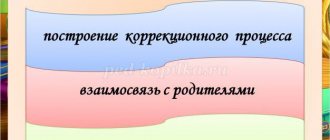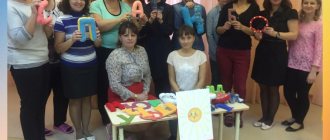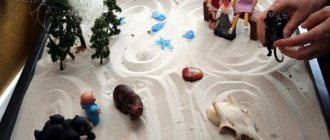Master class “Non-traditional methods and health-saving technologies in speech therapy classes”
MCOU "SERGOKALINSKAYA SOSH No. 1"
Master Class
“Non-traditional methods and health-saving technologies in speech therapy classes”
PREPARED AND CONDUCTED BY: TEACHER – Speech Pathologist
MCOU "SERGOKALINSKAYA SOSH No. 1" -
MUSAYEVA SABINA ZAPIROVNA
SERGOKALA-2016
Target:
the use of health preservation and non-traditional methods in the correctional educational process.
Tasks:
to teach the audience techniques for maintaining health: restoring strength, developing adaptability, relieving tension, stimulating performance and thinking.
Move
We must learn to relax and quickly restore our performance. To do this, we will do a series of exercises that will put our physical and mental state in order, relieve muscle tension and charge us with positive energy. Let's start. I call the participants. Take your seats.
1. Game for understanding spatial adverbs “Teams”
(I will give commands, and you carry them out)
Get up from your chair. Raise your hands up. Take me aside. Lower it down. Turn right, left, around. Point to the neighbor on the left. Point to your neighbor ahead. Point to the neighbor on the right. Point to your neighbor behind you. They sat down on the chairs.
Raise your hand, who doesn't have a neighbor to the left? Raise your hand, who doesn't have a neighbor on the right? Who doesn't have a neighbor in front? Who doesn't have a neighbor behind?
Was it difficult to navigate when we were tired and distracted?
2. “Journey through the body”
And now I will tell you the poem, and you show yourself everything that is named. Whatever you touch, stroke and massage!
There are nails on our fingers, wrists, elbows on our hands, crown, neck, shoulders, chest, and don’t forget the tummy! Hips, heels, two feet, lower leg and ankle. There are knees and a back, but there is only one! We have two ears and two lobes on our heads. Eyebrows, cheekbones and temples, And eyes that are so close. Cheeks, nose and two nostrils, Lips, teeth - look! Chin under lip That's what you and I know!
3. Let's move on to our breathing.
Did you know that breathing can be healing?
The development of speech breathing plays a big role in the development of correct speech. Breathing exercises develop long, uniform exhalation in children, form a strong air stream, and train situational phrasal speech. I motivate children’s interest in breathing exercises with a combination of visuals and funny poetic forms. Thus causing positive emotions, which also contribute to the development of children’s creative imagination and fantasy.
4. Relaxation
To relieve tension from the neck and muscles of the shoulder girdle (you wrote a lot today with your heads bowed), we’ll do the “Curious Varvara” relaxation exercise.
Goal: relaxation of the neck muscles.
a) Speech therapist - “Turn your head to the left, try to do it so that you can see as far as possible. Now the neck muscles are tense! Touch your neck on the right; the muscles have become hard as stone. Return to the starting position. Likewise in the other direction. Inhale - pause, exhale - pause.
Curious Varvara Looks to the left... Looks to the right... And then forward again - Here she will rest a little. The neck is not tense, but relaxed
».
The movements are repeated 2 times in each direction.
b) Speech therapist: “Now raise your head up. Look at the ceiling. Tilt your head back more! How tense my neck is! Unpleasant! It's hard to breathe. Stand up straight. It became easy, I could breathe freely. Inhale - pause, exhale - pause.
And Varvara looks up! Higher than everyone else, ever higher! Coming back - Relaxation is nice! The neck is not tense and relaxed
».
c) Speech therapist: “Now slowly lower your head down. The neck muscles become tense. They became hard at the back. Straighten your neck. She's relaxed. Nice, breathes well. Inhale - pause, exhale - pause.
Now let's look down - The neck muscles are tense! Let's go back - Relaxation is nice! The neck is not tense and relaxed
».
5. Now let’s put the muscles of the speech apparatus, lips and jaw in order.
Arms and legs are not tense, relaxed. Hands on knees.
Let's do the lip exercise “Proboscis”
(I use a picture)
I imitate an elephant, pulling my lips with my proboscis. And now I let them go and return them to their place. My lips are not tense and relaxed.
(lips tensed, but now they have become soft, relaxed).
Next exercise “Delicious honey”
(show picture).
All the people know this: the bear loves delicious honey. He licks his lip with his tongue and sits closer to the honey.
And now the “Nut” exercise
(show picture.) Imagine that you are cracking a hard nut. Clench your teeth tightly - like this. At the same time, the jaw tensed, became like stone (this is what we sometimes do when we are angry!) This is unpleasant. Unclench your jaws - it’s easy.
The squirrel cracks nuts thoroughly, without haste.
We rest the tongue Left and Right, on the side.
Now let’s tense and relax the muscles of the tongue: exercise “Angry Tongue”
(show picture) - (the tip of the tongue rests on the upper teeth, as if it wants to push them out, the tension is unpleasant. Listen and do as I do!
Something happened to the tongue: it pushes the teeth! It's like he wants to push his teeth out for something! He returns to his place and wonderfully relaxes!
Last exercise: “Slide”
(show picture) - tip of the tongue behind the lower teeth, the back is arched and tense - do it several times - tense the tongue - relax)
The back of our tongue will become a mound now! I tell her to melt - I don’t like tension! The tongue returns to its place and is wonderfully relaxed!
6. Now tell me, what’s your mood?
To the music, you must make facial expressions from the picture and pass it on to your neighbor. They handed over their masks and became themselves again. Has your mood changed?
7. Su-Jok therapy
What is Su Jok therapy? Translated from Korean, Su means hand, Jok means foot. Thus, Su Jok therapy is a treatment method using the hands and feet. The structure of the hand and foot shows an amazing similarity to the structure of the human body. In the human body, one can distinguish a torso and five protruding parts - a head with a neck and four limbs. Looking at our hand, we see that the hand also consists of a palm and five protruding parts - fingers.
The impact on the speech zones of the cerebral cortex involves the use of Su-Jok - ball simulators. This type of work can be used as an element of a lesson (frontal, subgroup or individual), as finger gymnastics, or in children’s independent activities, for example self-massage. A child of any age can use this ball independently by simply rolling it over their palms. But it’s much more interesting to make a whole game out of massage! You can give your baby a massage and at the same time tell an entertaining story to the bun.
Su-Jok balls can be used to automate sounds.
Automation of sounds.
The child rolls the massager between his palms, while reciting a poem to automate the disturbed sound (automation of sound (g)):
A hedgehog walks without paths
Doesn't run from anyone.
From head to toe
A hedgehog covered in needles.
How to take it?
The main advantages of using Su-Jok massagers for self-massage of the hands are as follows:
- Safety of use;
- Self-massage can be performed individually or with a group of children;
- Can be used repeatedly throughout the day, including self-massage at various scheduled moments in preschool settings;
- Self-massage can be incorporated into any activity;
- Children perform self-massage independently, under the supervision of an adult;
- Self-massage is carried out, usually in a playful way;
- Tactile stimulation is provided in a certain rhythm, which contributes to the formation of a sense of rhythm.
8. Visual gymnastics
To prevent visual fatigue and prevent the progression of eye diseases, periods of visual perception alternate during classes. Visual gymnastics using oculomotor exercises is carried out periodically. Exercises can be carried out using computer technology.
The use of the above health-saving technologies when carrying out correctional and speech therapy work, as well as the creation of the most diverse speech environment that is interesting for the child, helps to solve the problems of the harmonious development of preschoolers more effectively and in a short time, activates mental processes and shapes the personality of the child as a whole.
Be always healthy! I wish you success!
References
- Non-traditional methods in correctional pedagogy. / Compiled by M. A. Povalyaeva. – Rostov-on-Don: Phoenix, 2006. – 349 p.
- Vygotskaya, I. G. Elimination of stuttering in preschoolers in play situations: a book for speech therapist. / I. G. Vygotskaya, E. L. Pellinger, L. P. Uspenskaya. - M.: Education, 1993. - 223 p.
- Krupenchuk, O. I. Teach me to speak correctly! Speech therapy manual for children and parents. / O. I. Krupenchuk. — St. Petersburg : Litera Publishing House, 2001. - 208 p.
- Program for neuropsychological development and correction of children with attention deficit hyperactivity disorder. / Compiled by A. L. Sirotyuk, A. S. Sirotyuk.
- Health and rehabilitation measures in educational institutions based on the use of aromatic oils: Methodological recommendations. – Novokuznetsk, 2003. – 40 p.
- Uzorova, O. V. Finger gymnastics. / O. V. Uzorova, E. A. Nefedova. - M., Ast, Astrel, 2002. - 94 p.
- Sirotyuk A. L. Correction of education and development of schoolchildren. / A. L. Sirotyuk. – M.: TC Sfera, 2002. – 80 p.





